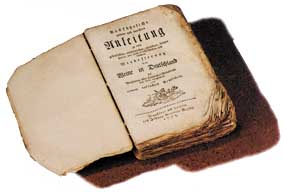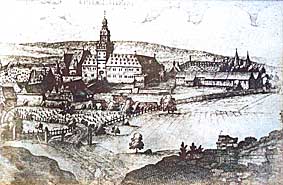History
The BONNET FAMILY - a piece of Franco-German history
g
|
The ancestors of the Bonnet family originally lived in France as peaceful citizens, wine-growers and devout Huguenots...a faith that ultimately shaped their destiny. Under Louis XIV of France, the Bonnets, like 250,000 other Huguenots, were forced to flee their homeland to escape persecution and save their lives. They fled eastward to Germany. Many settled in the Pfalz (Palatinate), where they were taken by the beautiful landscape and mild climate, in which even almonds and figs grew - and above all, vines were cultivated. |
 |
|
Sometime between 1572 and 1650 the Bonnet family must have chosen the Pfalz, which virtually borders on France, as their new home. In 1675, a Johanness Bonett (an orthographic error; Bonnet is the proper spelling) is mentioned for the first time in the local archives. It was recorded that he was a "Dorfmeister" and had to pay 1 Gulden and 15 Kreuzer as an immigration tax for the privilege of living there. The Bonnets brought with them generations of wine-growing experience and thus, were able to share their insights and ideas with wine-growers in their new homeland. Before long, they were acknowledged specialists in viticulture and indeed, a certain Heinrich Bonnet was mentioned as "a man of keen intellect" in "A Complete Treatise on Viticulture" published in 1767. |
 Schloß Friedelsheim anno 1625 |
Schloss Friedelsheim It is remarkable that a small wine village such as Friedelsheim once had town gates as well as a moated castle. From 1575-78, count palatine Johann Casimir built a palace and gardens on the grounds of the centuries-old town castle. On and off afterwards, it served as the residence of several counts palatine. Prince Elector Friedrich V of the Pfalz (1596-1632) chose Schloss Friedelsheim as the residence where his wife, Elizabeth Stuart, daughter of James I of England, could spend her widowhood. |
|
Today, nothing more than ruins bear silent witness to a glorious past, since the palace in Friedelsheim was almost totally burned down and destroyed by the French in 1794. Under Napoleon, the Pfalz was occupied by the French, who expropriated the property of the nobility. The castle, complete with servants' quarters, barns and cellars, was sold at auction and came into private hands. Because the bulk of the property was acquired by Mennonites, an Anabaptist group named after its founder Menno Simons (1492-1559), the castle courtyard was renamed "Mennonitenhof" - a name it has retained to this day. Later, the Bonnet family acquired a portion of the courtyard, the Zehntscheune and Zehntkeller (tithe barn and tithe cellars), where farmers and wine-growers were once obliged to annually deliver one tenth (a tithe) of their produce or wine as a tax to the local Elector or ruler. Because the Bonnet cellars are still located in parts of the old castle, the estate uses a silhouette of the castle as it looked in 1625 as a logo for the wines bearing the "Tradition Labels." |